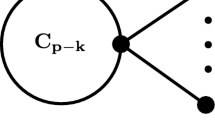Abstract
Given an irreducible fraction \(\frac{c}{d} \in [0,1]\), a pair \((\mathcal {A},\mathcal {B})\) is called a \(\frac{c}{d}\)-cross-intersecting pair of \(2^{[n]}\) if \(\mathcal {A}, \mathcal {B}\) are two families of subsets of [n] such that for every pair \(A \in \mathcal {A}\) and \(B\in \mathcal {B}\), \(|A \cap B|= \frac{c}{d}|B|\). Mathew et al. (Graphs Comb 37:471–484, 2019) proved that \(|\mathcal {A}||\mathcal {B}|\le 2^n\) if \((\mathcal {A}, \mathcal {B})\) is a \(\frac{c}{d}\)-cross-intersecting pair of \(2^{[n]}\) and characterized all the pairs \((\mathcal {A},\mathcal {B})\) with \(|\mathcal {A}||\mathcal {B}|=2^n\), such a pair also is called a maximal \(\frac{c}{d}\)-cross-intersecting pair of \(2^{[n]}\), when \(\frac{c}{d}\in \{0,\frac{1}{2}, 1\}\). In this note, we characterize all the maximal \(\frac{c}{d}\)-cross-intersecting pairs \((\mathcal {A},\mathcal {B})\) when \(0<\frac{c}{d}<1\) and \(\frac{c}{d}\not =\frac{1}{2}\), this result answers a question proposed by Mathew et al. (2019).
Similar content being viewed by others
Data Availability
Data sharing not applicable to this article as no datasets were generated or analysed during the current study.
References
Ahlswede, R., Cai, N., Zhang, Z.: A general 4-words inequality with consequences for 2-way communication complexity. Adv. Appl. Math. 10(1), 75–94 (1989)
Alon, N., Lubetzky, E.: Uniformly cross intersecting families. Combinatorica 29, 389–431 (2009)
Alon, N., Babai, L., Suzuki, H.: Multilinear polynomials and Frankl–Ray–Chaudhuri–Wilson type intersection theorems. J. Combin. Theory Ser. A 58, 165–180 (1991)
Balachandran, N., Mathew, R., Mishra, T.K.: Fractional \(L\)-intersecting families. Electron. J. Combin. 26(2), P2.40 (2019)
Bose, R.: A note on Fisher’s inequality for balanced incommplete block design. Ann. Math. Stat. 20(4), 619–620 (1949)
Brouwer, A.E., Cohen, A.M., Neumamier, A.: Distance-Regular Graphs, vol. 18. Springer Science and Business Media, Berlin (2012)
Erdős, P., Ko, C., Rado, R.: Interseection theorems for systems of finite sets. Quart. J. Math. 12, 313–320 (1961)
Frankl, P., Wilson, R.M.: Intersection theorems with geometric consequences. Combinatorica 1, 357–368 (1981)
Frankl, P., Lee, S.J., Siggers, M., Tokushige, N.: An Erdős–Ko–Rado theorem for cross \(t\)-intersecting families. J. Comb. Theorey Ser. A 128, 207–249 (2014)
Grolmusz, V., Sudakov, B.: On \(k\)-wise set-intersections and \(k\)-wise hamming-distances. J. Combin. Theory Ser. A 99, 180–190 (2002)
Liu, J., Yang, W.: set systems with restricted \(k\)-wise \(L\)-intersections modulo a prime number. Eur. J. Comb. 36, 707–719 (2014)
Mathew, R., Ray, R., Srivastava, S.: Fractional cross intersecting families. Graphs Comb. 37, 471–484 (2019)
Pyper, L.: A new generalization of the Erdős–Ko–Rado theorem. J. Comb. Theory Ser. A 43(1), 85–90 (1986)
Qian, J., Ray-Chaudhuri, D.K.: On Mod-p Alon–Babai–Suzuki inequality. J. Algebraic Combin. 12, 85–93 (2000)
Ray-Chaudhuri, D.K., Wilson, R.M.: On \(t\)-designs. Osaka J. Math. 12(3), 737–744 (1975)
Snevily, H.S.: On generalizations of the de Bruijn–Erdős theorem. J. Combin. Theory Ser. A 68, 232–238 (1994)
Snevily, H.S.: A sharp bound for the number of sets that pairwise intersect at \(k\) positive values. Combinatorica 23, 527–533 (2003)
Funding
The funding has been received from National Natural Science Foundation of China with Grant no. 12071453
Author information
Authors and Affiliations
Corresponding author
Ethics declarations
Conflict of interest
No conflict of interest exits in the submission of this manuscript, and manuscript is approved by all authors for publication. I would like to declare on behalf of my co-authors that the work described was original research that has not been published previously, and not under consideration for publication elsewhere, in whole or in part. All the authors listed have approved the manuscript that is enclosed.
Additional information
Publisher's Note
Springer Nature remains neutral with regard to jurisdictional claims in published maps and institutional affiliations.
The work was supported by the National Natural Science Foundation of China (No. 12071453), the National Key R and D Program of China (2020YFA0713100), and the Innovation Program for Quantum Science and Technology, China (2021ZD0302902).
Rights and permissions
Springer Nature or its licensor (e.g. a society or other partner) holds exclusive rights to this article under a publishing agreement with the author(s) or other rightsholder(s); author self-archiving of the accepted manuscript version of this article is solely governed by the terms of such publishing agreement and applicable law.
About this article
Cite this article
Wang, H., Hou, X. Maximal Fractional Cross-Intersecting Families. Graphs and Combinatorics 39, 81 (2023). https://doi.org/10.1007/s00373-023-02674-4
Received:
Revised:
Accepted:
Published:
DOI: https://doi.org/10.1007/s00373-023-02674-4



